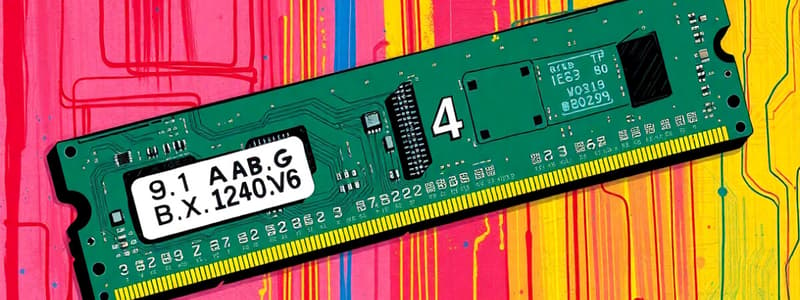Podcast
Questions and Answers
What is the minimum recommended RAM for a computer running Windows 7?
What is the minimum recommended RAM for a computer running Windows 7?
- 1 GB
- 2 GB (correct)
- 4 GB
- 8 GB
Which specification describes the speed of DDR4 memory?
Which specification describes the speed of DDR4 memory?
- 10660 MB/s
- 2133 MHz to 3200 MHz (correct)
- 1333 MHz
- 9-9-9
What does the term 'clock speed' refer to in the context of processors?
What does the term 'clock speed' refer to in the context of processors?
- The amount of cache memory in the processor
- The voltage requirements of the CPU
- The number of processor cores
- The speed at which a processor executes instructions (correct)
What feature allows multi-core processors to run more efficiently with modern software?
What feature allows multi-core processors to run more efficiently with modern software?
What is typically the cache size found in low-end Celeron processors?
What is typically the cache size found in low-end Celeron processors?
Which of the following statements is FALSE regarding integrated GPUs?
Which of the following statements is FALSE regarding integrated GPUs?
What is an important consideration for processor compatibility with a motherboard?
What is an important consideration for processor compatibility with a motherboard?
What does CAS stand for in memory performance specifications?
What does CAS stand for in memory performance specifications?
What does the CPU frequency indicate?
What does the CPU frequency indicate?
In a CPU with a frequency of 2.4 GHz and a Front Side Bus of 400 MHz, what is the CPU to FSB ratio?
In a CPU with a frequency of 2.4 GHz and a Front Side Bus of 400 MHz, what is the CPU to FSB ratio?
Which specification is NOT directly related to the efficiency of a video card?
Which specification is NOT directly related to the efficiency of a video card?
What frame rate is generally considered necessary for smooth animation and scrolling in fast-acting games?
What frame rate is generally considered necessary for smooth animation and scrolling in fast-acting games?
How is FSB speed typically expressed?
How is FSB speed typically expressed?
What does the pixel fill rate of a graphics card measure?
What does the pixel fill rate of a graphics card measure?
Which of the following factors is least likely to affect the processing speed of a graphics card?
Which of the following factors is least likely to affect the processing speed of a graphics card?
What is measured in frames per second (FPS) when evaluating a video card's performance?
What is measured in frames per second (FPS) when evaluating a video card's performance?
Flashcards are hidden until you start studying
Study Notes
Memory
- RAM is measured in Megabytes (MB) and Gigabytes (GB), with the required amount depending on software needs.
- Windows XP requires a minimum of 1 GB RAM; Windows 7 requires at least 2 GB.
- Performance attributes of memory include:
- Speed (measured in MHz)
- Timing (CAS - Column Access Strobe)
- Voltage
- Typical memory speeds for DDR4 range from 2133 MHz to 3200 MHz.
- Example DDR3 Technical Specifications:
- Speed Grade: 1333 Mbps
- Unbuffered DIMM: 240-pin
- CAS latency: 9-9-9
- Bandwidth: 10660 MB/s
Processor
- The CPU conducts calculations and processes instructions from the operating system.
- Clock speed denotes processor speed, typically in gigahertz (GHz), with modern processors reaching up to 4.7 GHz.
- Key criteria for selecting a processor:
- Cores: Ranges from dual-core to 8-core, with options including Core 2, i3, i5, and i7.
- Cache: Fast memory in MB, with low-end processors having around 0.25 MB and high-end processors up to 24 MB.
- Socket compatibility: Ensure compatibility between the motherboard and CPU after purchase.
- Integrated GPUs: Provides graphics processing; optional if a separate graphics card is present.
- Frequency: CPU speed; potentially lower frequency CPUs may outperform higher frequency counterparts due to architecture efficiency.
- Front Side Bus (FSB): Communication link between CPU and memory, measured in Hz, ranging from 66 MHz to 800 MHz or higher.
- Example of Intel® Core™ i5 Processor Specifications:
- Product Collection: 7th Generation i5
- Number of Cores: 4
- Max Turbo Frequency: 3.50 GHz
- Cache: 6 MB SmartCache
- TDP: 65 W
- Number of Threads: 4
- Bus Speed: 8 GT/s DMI3
- Base Frequency: 3.00 GHz
Video Card
- Known as graphics card or display adapter, connects to motherboard and processes images/videos.
- GPU efficiency determines the speed and visual quality, measured by frame rate (FPS).
- Human perception processes about 25 FPS; fast games typically require a minimum of 60 FPS for smooth visuals.
- Frame rate elements include:
- Triangles per second: Measures how fast the GPU can render polygons for 3D images.
- Pixel fill rate: Indicates how quickly the GPU can process image pixels.
- Key hardware specifications affecting graphics card speed:
- GPU clock speed (MHz)
- Size of memory bus (bits)
- Amount of memory available (MB)
- Memory clock rate
Studying That Suits You
Use AI to generate personalized quizzes and flashcards to suit your learning preferences.




